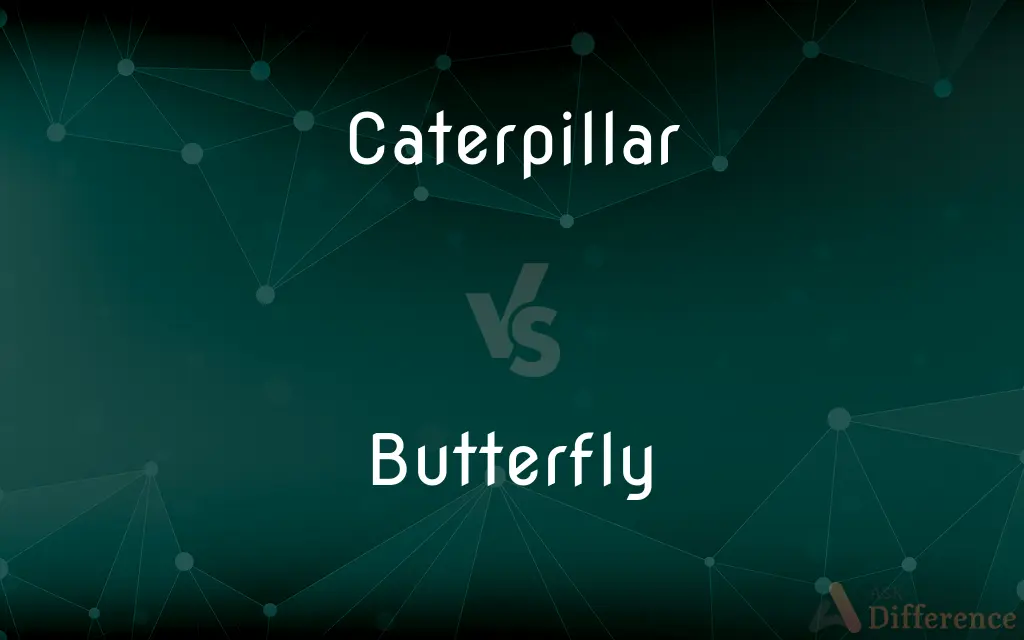Caterpillar vs. Butterfly — What's the Difference?
By Tayyaba Rehman & Urooj Arif — Updated on March 21, 2024
Caterpillars are the larval stage of butterflies, focusing on eating and growth, whereas butterflies are the young stage, characterized by reproduction and pollination.

Difference Between Caterpillar and Butterfly
Table of Contents
ADVERTISEMENT
Key Differences
During the caterpillar stage, these insects undergo several molts as they grow, shedding their skin to accommodate their increasing size. This stage is characterized by significant physical change, preparing for metamorphosis. Butterflies, after emerging from the chrysalis or pupa stage, undergo no further molts; their bodies are designed for flight, feeding on nectar, and reproduction. They possess compound eyes, antennae, and a proboscis—a long, coiled tube for sucking nectar.
Caterpillars can be found in a variety of environments, primarily on the plants that serve as their food source. They are equipped with adaptations that help in defense against predators, such as camouflage, spines, or toxic chemicals. Butterflies contribute to their ecosystems differently; by moving from flower to flower to feed, they play a crucial role in pollination, helping plants to reproduce and increasing biodiversity.
The transformation from caterpillar to butterfly is one of nature's most striking examples of metamorphosis. This process involves the caterpillar forming a chrysalis around itself and then completely reorganizing its body structure to emerge as a butterfly. This metamorphosis symbolizes change and growth, making it a subject of fascination and study.
While caterpillars and butterflies may seem vastly different in appearance and behavior, they are two stages of the same organism's life cycle, demonstrating the dramatic transformations that some species undergo through their development.
Comparison Chart
Focus
Eating and growth
Reproduction and pollination
ADVERTISEMENT
Body Structure
Tubular, segmented, with many legs
Wingspan, fewer legs, designed for flight
Diet
Leaves and plant matter
Nectar from flowers
Role in Ecosystem
Herbivore, prey for many species
Pollinator, contributes to plant reproduction
Defensive Mechanisms
Camouflage, spines, toxic chemicals
Coloration for camouflage or warning
Compare with Definitions
Caterpillar
Characterized by a segmented body and multiple sets of legs.
The caterpillar used its legs to grip the leaf tightly.
Butterfly
The young stage of a lepidopteran, featuring wings for flight.
Butterflies are attracted to gardens with a variety of flowers.
Caterpillar
Primarily herbivorous, feeding on leaves.
Caterpillars in the garden can be a sign of a healthy ecosystem.
Butterfly
Exhibits vibrant colors and patterns on its wings.
The butterfly's wings displayed a stunning array of colors.
Caterpillar
The larval stage of butterflies and moths, known for their eating habits.
The monarch caterpillar feeds exclusively on milkweed.
Butterfly
Plays a crucial role in ecosystems as pollinators.
Butterflies help pollinate flowers, supporting biodiversity.
Caterpillar
Undergoes multiple molts before metamorphosis.
After its final molt, the caterpillar began forming its chrysalis.
Butterfly
Feeds on nectar, contributing to pollination.
The butterfly's proboscis uncoiled to reach the nectar.
Caterpillar
Utilizes defense mechanisms like camouflage.
The caterpillar's green color helps it blend in with the leaves.
Butterfly
A nectar-feeding insect with two pairs of large, typically brightly coloured wings that are covered with microscopic scales. Butterflies are distinguished from moths by having clubbed or dilated antennae, holding their wings erect when at rest, and being active by day.
Caterpillar
Caterpillars ( CAT-ər-pil-ər) are the larval stage of members of the order Lepidoptera (the insect order comprising butterflies and moths). As with most common names, the application of the word is arbitrary, since the larvae of sawflies are commonly called caterpillars as well.
Butterfly
A stroke in swimming in which both arms are raised out of the water and lifted forwards together.
Caterpillar
The wormlike larva of a butterfly or moth.
Butterfly
Split (a piece of meat or fish) almost in two and spread it out flat
Butterfly the shrimp using a small sharp knife
Caterpillar
Any of various insect larvae similar to those of the butterfly or moth.
Butterfly
Any of numerous insects of the order Lepidoptera, having four broad, usually colorful wings, and generally distinguished from the moths by having a slender body and knobbed antennae and being active during the day.
Caterpillar
The larva of a butterfly or moth; leafworm
The bird just ate that green caterpillar.
Butterfly
A person interested principally in frivolous pleasure
A social butterfly.
Caterpillar
A vehicle with a caterpillar track; a crawler
Butterfly
A swimming stroke in which a swimmer lying face down draws both arms upward out of the water, thrusts them forward, and draws them back under the water in an hourglass design while performing a dolphin kick.
Caterpillar
(maths) A set of subtrees of a tree
Butterfly
A race or a leg of a race in which this stroke is swum.
Caterpillar
The larval state of a butterfly or any lepidopterous insect; sometimes, but less commonly, the larval state of other insects, as the sawflies, which are also called false caterpillars. The true caterpillars have three pairs of true legs, and several pairs of abdominal fleshy legs (prolegs) armed with hooks. Some are hairy, others naked. They usually feed on leaves, fruit, and succulent vegetables, being often very destructive, Many of them are popularly called worms, as the cutworm, cankerworm, army worm, cotton worm, silkworm.
Butterfly
Butterflies A feeling of unease or mild nausea caused especially by fearful anticipation.
Caterpillar
A plant of the genus Scorpiurus, with pods resembling caterpillars.
Butterfly
To cut and spread open and flat, as shrimp.
Caterpillar
A wormlike and often brightly colored and hairy or spiny larva of a butterfly or moth
Butterfly
A flying insect of the order Lepidoptera, distinguished from moths by their diurnal activity and generally brighter colouring.
Caterpillar
A large vehicle that is driven by caterpillar tracks; frequently used for moving earth in construction and farm work
Butterfly
A use of surgical tape, cut into thin strips and placed across an open wound to hold it closed.
Butterfly tape; butterfly bandage; butterfly strips
Butterfly
(swimming) The butterfly stroke.
Butterfly
Any of several plane curves that look like a butterfly; see Butterfly curve (transcendental) and Butterfly curve (algebraic). Category:en:Curves
Butterfly
(in plural) A sensation of excited anxiety felt in the stomach.
I get terrible butterflies before an exam.
Butterfly
Someone seen as being unserious and (originally) dressed gaudily; someone flighty and unreliable.
Butterfly
(finance) A combination of four options of the same type at three strike prices giving limited profit and limited risk.
Butterfly
(alternate history) A random change in an aspect of the timeline seemingly unrelated to the primary point of divergence, resulting from the butterfly effect.
One potential butterfly could be JFK having another son the year after the POD instead of a daughter.
Butterfly
(sports) A type of stretch in which one sits on the ground with the legs folded into a shape like that of a butterfly's wings, slightly rocking them up and down, resembling the wings fluttering.
Butterfly
A person who changes partners frequently.
Butterfly
(transitive) To cut (food) almost entirely in half and spread the halves apart, in a shape suggesting the wings of a butterfly.
Butterflied shrimp
Butterfly the chicken before you grill it.
Butterfly
(transitive) To cut strips of surgical tape or plasters into thin strips, and place across (a gaping wound) to close it.
Butterfly
To cause events after the point of divergence to not happen as they did in real history, and people conceived after the point of divergence to not exist in recognizable form, due to the random variations introduced by the butterfly effect.
Pearl Harbor not happening would've butterflied Taylor Swift.
Butterfly
A general name for the numerous species of diurnal Lepidoptera.
Butterfly
Diurnal insect typically having a slender body with knobbed antennae and broad colorful wings
Butterfly
A swimming stroke in which the arms are thrown forward together out of the water while the feet kick up and down
Butterfly
Flutter like a butterfly
Butterfly
Cut and spread open, as in preparation for cooking;
Butterflied shrimp
Butterfly
Talk or behave amorously, without serious intentions;
The guys always try to chat up the new secretaries
My husband never flirts with other women
Common Curiosities
How do butterflies eat?
Butterflies use a long, coiled tube called a proboscis to suck nectar and other liquids from flowers.
How do butterflies contribute to the environment?
Butterflies pollinate plants while feeding on nectar, playing a vital role in the reproduction of many plant species.
Why do caterpillars eat so much?
Caterpillars need to accumulate a large amount of energy in the form of fat and nutrients to support their metamorphosis into butterflies.
What causes a caterpillar to transform into a butterfly?
The transformation, or metamorphosis, is triggered by hormonal changes when the caterpillar reaches a certain size and developmental stage.
Can all caterpillars become butterflies?
Yes, all caterpillars are the larval stage of butterflies or moths and will undergo metamorphosis if they survive this stage.
Why are butterflies' wings so colorful?
The colors and patterns can serve various purposes, including attracting mates, camouflage, and warning predators of toxicity.
How do butterflies migrate?
Some butterfly species, like the monarch, undertake long migrations to escape cold weather and find suitable breeding grounds.
How can I attract butterflies to my garden?
Planting a variety of nectar-rich flowers and providing sunny, sheltered spots for basking can attract butterflies.
Can I keep a caterpillar as a pet?
While it's possible, it requires careful attention to provide the right food and environment for it to thrive and metamorphose.
Do all caterpillars look the same?
No, caterpillars vary greatly in color, pattern, and size, depending on their species.
Do caterpillars have wings inside their chrysalis?
Inside the chrysalis, the caterpillar's body is completely reorganized, and the wings are formed as part of this process.
Can butterflies remember being caterpillars?
Research suggests that some butterflies can retain memories from their caterpillar stage, despite the drastic transformation.
Is it true that some caterpillars are poisonous?
Yes, some caterpillars contain toxins as a defense mechanism against predators.
What is the difference between a butterfly and a moth?
Though both are Lepidoptera, they differ in traits like wing folding habits, antennae shape, and activity patterns (butterflies are diurnal, while many moths are nocturnal).
Share Your Discovery

Previous Comparison
Evaluation vs. Interpretation
Next Comparison
Journalist vs. CorrespondentAuthor Spotlight
Written by
Tayyaba RehmanTayyaba Rehman is a distinguished writer, currently serving as a primary contributor to askdifference.com. As a researcher in semantics and etymology, Tayyaba's passion for the complexity of languages and their distinctions has found a perfect home on the platform. Tayyaba delves into the intricacies of language, distinguishing between commonly confused words and phrases, thereby providing clarity for readers worldwide.
Co-written by
Urooj ArifUrooj is a skilled content writer at Ask Difference, known for her exceptional ability to simplify complex topics into engaging and informative content. With a passion for research and a flair for clear, concise writing, she consistently delivers articles that resonate with our diverse audience.
















































